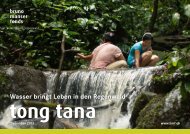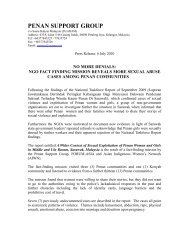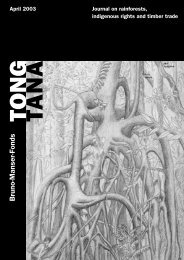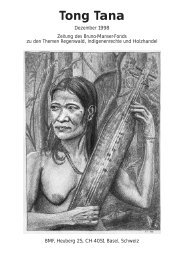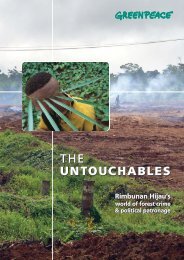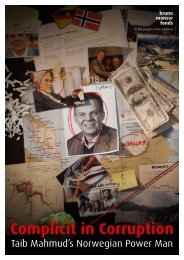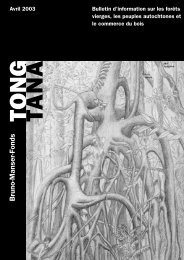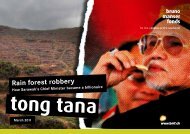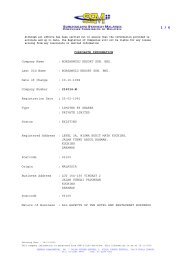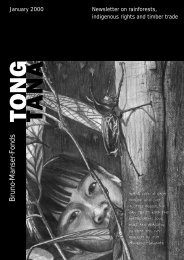Tong Tana - Bruno Manser Fonds
Tong Tana - Bruno Manser Fonds
Tong Tana - Bruno Manser Fonds
You also want an ePaper? Increase the reach of your titles
YUMPU automatically turns print PDFs into web optimized ePapers that Google loves.
Forestry in Sarawak<br />
Professor em. Eberhard F. Bruenig,<br />
Associate Member, Oxford<br />
Forestry Institute, Oxford University,<br />
who worked in the Sarawak<br />
Forestry Department from<br />
1954–1963 and 1990–1996,<br />
talked to John Künzli<br />
Responding to a question by <strong>Bruno</strong> <strong>Manser</strong><br />
whether the development of the forestry and<br />
forest industry could be described as catastrophic,<br />
Professor Bruenig asserted that, with<br />
respect to the development in the last three<br />
decades, this could be said with the following<br />
qualifications.<br />
Timber trade, and to a certain degree, the<br />
wood-processing industry flourished, while<br />
the forest growing stock capital was depleted<br />
quickly and drastically, at the expense of future<br />
prospects. Rash and wasteful growing<br />
stock depletion and exodus of capital caused<br />
ecological damages to site and forest stand<br />
caused by the generally careless and inadequate<br />
construction of roads and tracks, inappropriate<br />
harvesting technology, destructive<br />
logging practices and overlogging.<br />
All this could have been avoided, however,<br />
if the political will and strength had been<br />
there. Commercial interests of indigenous and<br />
foreign power-holding groups were, since the<br />
mid-1960s, primarily cash-flow orientated.<br />
The combination of lack of governmental control,<br />
ready markets, pressing buyers and the<br />
in theory free but in reality manipulated and<br />
distorted markets, was ideal for those who<br />
cleverly and in many ways were out to maximise<br />
private profits. The position of the<br />
power-holders was strong enough to fend off<br />
any outside interference. Even the Malaysian<br />
Federal Government found it difficult to make<br />
itself heard. This only changed with the emergence<br />
of the rainforest movements in the international<br />
political and NGO arena. During<br />
the whole period, only a few companies had,<br />
to some extent, managed to adhere to the<br />
principles of sustainability and complied with<br />
existing rules, regulations and management<br />
prescriptions.<br />
Recently for example, the German Technical<br />
Assistance Agency (GTZ – Project FOMISS) is<br />
helping the Samling Co. to implement lowimpact<br />
logging techniques and sustainable<br />
management approaches. (However, even<br />
then, the elusive issues of social justice and customary<br />
or statutory rights of land and resource<br />
ownership remained outside the concern of<br />
Samling Co. The co-operation with GTZ<br />
effected little change.) If forest values worth mentioning<br />
are to be saved, the existing principles,<br />
codes and guidelines for sustainable management,<br />
nature conservation and environment<br />
protection must be enforced without delay in all<br />
concession areas. This would cause 20–30% of<br />
the area of Sarawak’s permanent forest estate<br />
to be automatically excluded from logging and<br />
totally protected in its pristine state as a result of<br />
excessive slopiness, water catchment and<br />
stream/river bank protection or because of<br />
particular ecological sensitivity or uniqueness.<br />
In addition, another 5–10% of each concession<br />
area would be excluded from logging for various<br />
reasons such as poor accessibility or poor<br />
quality. Another 10% outside the producing<br />
forest estate should, according to government<br />
policy, be established as national park, wildlife<br />
sanctuary or biosphere reserve. The total area<br />
of preserved pristine forest would then be very<br />
substantial in absolute and relative terms which<br />
should satisfy any conservationist, environmentalist<br />
and anthropologist.<br />
However, the reality is rather different and<br />
the forest growing stock liquidation and forest<br />
area decline continue almost unabated. Nature<br />
and forest protection have made no notable<br />
headway. The large newly designated<br />
totally protected areas are intentions which<br />
are only slowly established on the ground and<br />
largely remain on paper. Satellite images indicate<br />
that exploitation of Sarawak’s forests<br />
progressed rapidly and engulfs many areas<br />
which should, under any circumstance and aspect,<br />
be totally protected. This causes not only<br />
damage to the sites, forests, environment and<br />
water bodies, but also irreversibly destroys<br />
unique heritage sites and ecosystems.<br />
The Environmental Impact Assessment<br />
(EIA) which is mandatory for any forestry operation<br />
above a specified size is applied reluctantly<br />
or entirely circumvented. Of particular<br />
ecological and economical alarm are the<br />
continued exploitation and destruction of the<br />
fragile Alan-Peatswamp forest ecosystems<br />
which are unique as ecosystem and global<br />
heritage, and the hazardous plan to replace<br />
all types of natural peatswamp forest by<br />
agricultural plantations. A credible and well<br />
implemented EIA and certification would<br />
probably stop the former and prevent the<br />
latter. However, a hopeful sign that a wind of<br />
change is blowing effectively, is the activity<br />
in recent years of the Malaysian Federal<br />
Government towards a national scheme of<br />
certification to support development towards<br />
sustainable forest management and conservation.<br />
5



